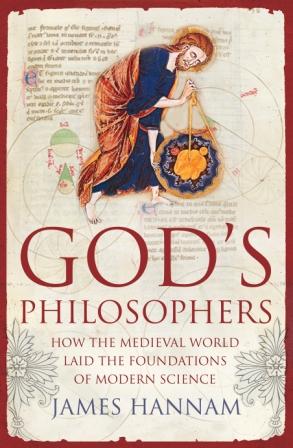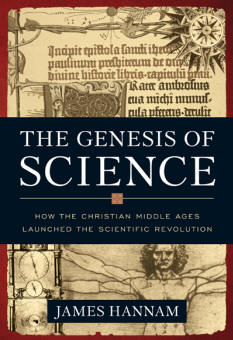
|
If you have enjoyed Bede's Library, you can order my book, The Genesis of Science: How the Christian Middle Ages Launched the Scientific Revolution (US) from Amazon.com or God's Philosophers: How the Medieval World Laid the Foundations of Modern Science (UK) from Amazon.co.uk. |
|
For my latest thoughts on science, politics, religion and history, read Quodlibeta |
![]()
![]()
![]()
![]()
The Myth of the Flat Earth
![]()
Introduction
We all know that Christopher Columbus encountered stiff resistance about his idea of sailing off West to try and reach the East Indies. Many of us have laboured under the impression that people were concerned that he would sail off the edge of the Earth which was widely believed to be flat. History is thought to have vindicated Columbus against those filled with the Christian superstition of a flat Earth who held on to old fashioned beliefs. A minority of people are even under the impression that Galileo's trial centred on the subject rather than whether the Earth orbited the sun.
It comes as some surprise, therefore, to find that Columbus was wrong and his critics were right - not because the world is actually flat after all, but because at the time everyone knew it was a globe and were arguing about how big it was. The idea that the uncouth people of the Middle Ages thought the Earth was flat is an example of the myth that has been propagated since the nineteenth century to give us a quite unfair view of this vibrant and exciting period.
Christopher Columbus
So what was Columbus's mistake? The disagreement between him and his critics was over the size of the world - not an easy thing to measure. The story of this controversy can be traced back to the ancient Greeks and the various ways their writings were transmitted to the West.
The Greeks had tried hard to find out how large the Earth is and managed to calculate many different figures depending on the methods and accuracy of their work. The most famous effort today is that of Eratosthenes, Librarian of Alexandria, who wrote a treatise On the Measurement of the Earth (now lost) in which he gave a figure for the Earth's circumference of 250,000 stadia. Depending on how long a stadia actually was this is the equivalent of about 23,000 miles, creditably close to the true figure of 24,900 miles. However, given his method involved pacing out the distance between two points 500 miles apart, we must allow that he enjoyed a good deal of luck as well.
At the time Eratosthenes's result did not demand universal assent and was widely seen as too big. A more popular figure is that given in by Strabo and Ptolemy, two distinguished Greek geographers of around the first century AD who both suggested 180,000 stadia. We are not sure where they got their figures from but they were repeated by the Latin writer Seneca who transmitted them to the medieval West. By the time that it became a live issue for Columbus, Eratosthenes' figure was back in vogue and the experts were wisely urging the Italian not to set sail. In particular a committee set up in Salamanca examined the plans and rejected them on the grounds that Columbus had underestimated the distance he would have to travel. Their concern is easy to understand - imagine how much trouble Columbus would have been in if the Americas had not been there. He could not possibly have survived the trip all the way to the east coast of Asia and was very lucky that some land intervened before he and his crew had to pay for his mistake. In the end, however, Queen Isabella of Spain was won over and donated the resources required.
It is not difficult to see how the story of Columbus was adapted so that he became the figure of progress rather than a lucky man who profited from his error. According to Jeffrey Burton Russell here, the invention of the flat Earth myth can be laid at the feet of Washington Irving, who included it in his historical novel on Columbus, and the wider idea that the everyone in the Middle Ages was deluded has been widely accepted ever since.
The Real Flat Earthers
The myth that Christians in the Middle Ages thought the world was flat was given a massive boost by Andrew Dickson White's weighty tome The Warfare of Science with Theology. This book has become something of a running joke among historians of science and it is dutifully mentioned as a prime example of misinformation in the preface of most modern works on science and religion. The flat Earth is discussed in chapter 2 and one can almost sense White's confusion that hardly any of the sources support his hypothesis that Christians widely believed in it. He finds himself grudgingly admitting that Clement, Origen, Ambrose, Augustine, Isodore, Albertus Magnus and Aquinas all accepted the Earth was a globe - in other words none of the great doctors of the church had considered the matter in doubt. Although an analysis of what White actually says suggests he was aware that the flat Earth was largely a myth, he certainly gives an impression of ignorant Christians suppressing rational knowledge of its real shape.
Luckily for White there were then, as there are now, a few fringe writers who could be counted upon to support any point of view no matter how wild. Cosmas Indicopleustes was one such man. He was a merchant traveller who retired to become a monk in the Egyptian desert where he wrote a treatise on Christian Topology that included his flat Earth cosmology. It was widely ignored at the time and Christian scholars like John Philoponus derided it as the work of an uneducated fool. So it was and it was soon forgotten. Because it was written in Greek, it was unavailable and unknown in the Latin West where, contrary to White's insinuations, it had no influence at all. First published with a Latin translation only in 1776, the book has since gained far wider recognition that it ever had in its day.
Lactantius was another church father who did seem sure the earth was flat but no one paid much attention to him either. Other early Christians may well have simply been using common language that we still use today. Saying "to the ends of the earth", "the four corners of the world" or "the sun sank into the sea" does not make you a flat Earther and we should treat ancient people with the same generosity. What can be stated categorically was that a flat Earth was at no time ever an element of Christian doctrine and that no one was ever persecuted or pressurised into believing it. This is interesting because the Bible itself implies the Earth is flat (for example at Daniel 4:11 or 4:8 in Catholic Bibles) and most of its writers (certainly those of the Old Testament) probably thought so. Clearly, belief in the complete scientific accuracy of the scriptures against known facts was not upheld by the early or medieval church who were happy to accept a figurative interpretation. You can read a full analysis of the different writers who have mentioned the shape of the earth in the e-book The Flat Earth by 'Ethical Atheist'.
Anti-clerical history of science writers have promulgated the myth so that even today, in his book The Discoverers, Daniel Boorstin manages to produce a totally misleading account (although he eventually gets Columbus right). His bias shows badly when he castigates Christians for thinking the world was flat when they did not and then praises the erudition of Chinese geographers who actually did believe it. The myth is so prevalent that the blurb on the back cover of the UK version of Umberto Eco's Serendipities, the editor repeats the myth even though within the book itself, Eco devotes a good deal of attention to debunking it!
The doyen of historians of Medieval Science, Edward Grant, covers the issue in his new book, God and Reason in the Middle Ages where he finds all educated people in the Middle Ages were well aware the Earth was a sphere. Perhaps today we can at last dispense with this patronising belief about the Christian Middle Ages.
![]()

